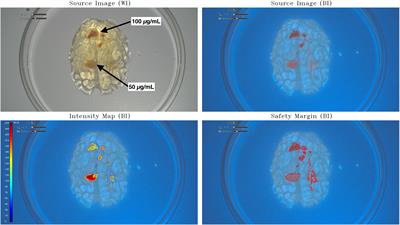Automated online safety margin (GLIOVIS) for glioma surgery model
Purpose: Glioblastoma is the most common type of primary brain malignancy and has a poor prognosis.

The standard treatment strategy is based on maximal safe surgical resection followed by radiotherapy and chemotherapy. Surgical resection can be optimized by using 5-delta-aminolevulinic acid (5-ALA)–induced fluorescence, which is the current mainstay. Although 5-ALA–induced fluorescence has gained general acceptance, it is also limited by inter-observer variability and non-standardized fluorescence parameters. We present a new software for processing images analysis to better recognize the tumor infiltration margins using an intraoperative immediate safety map of 5-ALA–induced fluorescence. We tested this in a brain model using a commercial surgical exoscope. Methods: A dedicated software GLIOVIS (ACQuF-II, Advanced Colorimetry-based Quantification of Fluorescence) was designed for processing analysis of images taken on the Intraoperative Orbital Camera Olympus Orbeye (IOC) to determine the relative quantification of Protoporphyrin IX (5-ALA metabolite) fluorescence.
The software allows to superpose the new fluorescence intensity map and the safety margins over the original images.
The software was tested on gel-based brain models. Results: Two surrogate models were developed: PpIX agarose gel–integrated in gelatin-based brain model at different scales (1:25 and 1:1).
The images taken with the IOC were then processed using GLIOVIS.
The intensity map and safety margins could be obtained for all available models. Conclusions: GLIOVIS for 5-ALA–guided surgery image processing was validated on various gelatin-based brain models. Different levels of fluorescence could be qualitatively digitalized using this technique.
These results need to be further confirmed and corroborated in vivo and validated clinically in order to define a new standard of care for glioblastoma resection.
Read the full article at the original website
References:
